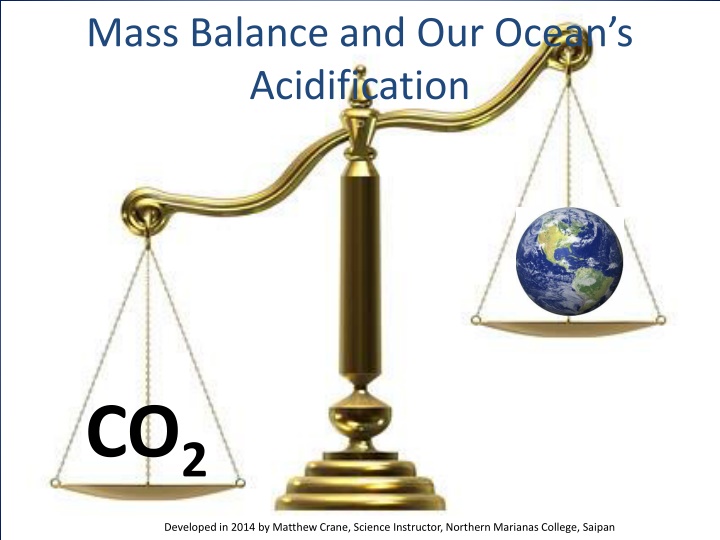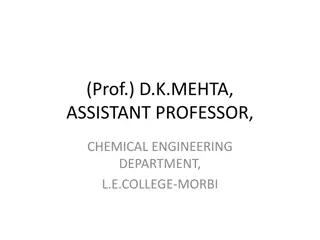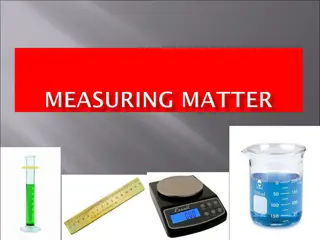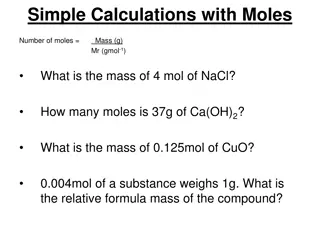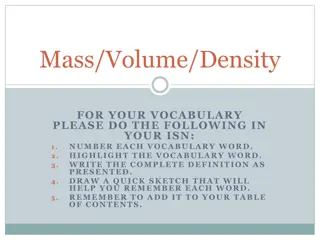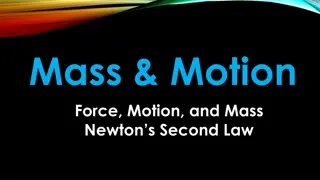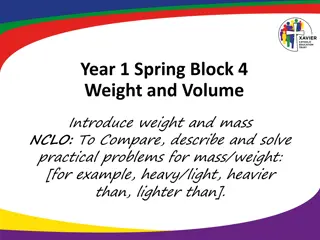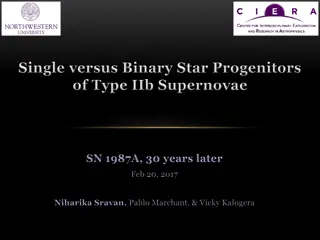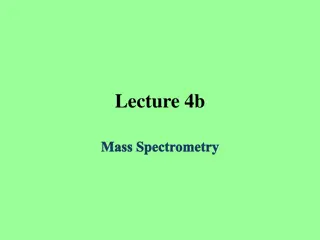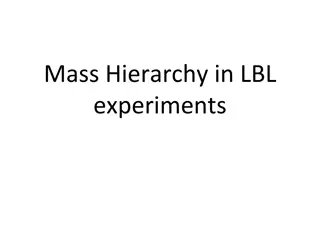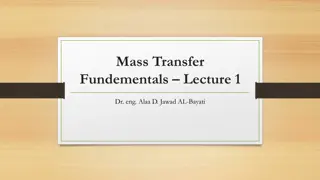Mass Balance in Systems
Mass balance is a crucial concept in various fields, ensuring that inputs and outputs within a system remain constant. This balance is applied in environmental science and daily scenarios like filling a bathtub. Explore how mass balance calculations help maintain equilibrium and solve practical problems efficiently.
Download Presentation

Please find below an Image/Link to download the presentation.
The content on the website is provided AS IS for your information and personal use only. It may not be sold, licensed, or shared on other websites without obtaining consent from the author.If you encounter any issues during the download, it is possible that the publisher has removed the file from their server.
You are allowed to download the files provided on this website for personal or commercial use, subject to the condition that they are used lawfully. All files are the property of their respective owners.
The content on the website is provided AS IS for your information and personal use only. It may not be sold, licensed, or shared on other websites without obtaining consent from the author.
E N D
Presentation Transcript
Mass Balance and Our Oceans Acidification CO2 Developed in 2014 by Matthew Crane, Science Instructor, Northern Marianas College, Saipan
What is Mass Balance The law of conservation of mass implies that mass can neither be created nor destroyed.1 Within a system mass should remain constant. What about inputs or output to the system?
What is Mass Balance Mass Balance is a technique used to account for any inputs or outputs of material to the system. Mass Balance is used in many fields, including environmental science. Kg
What is Mass Balance Change in storage of mass = mass transported in - mass transported out + mass produced by sources - mass eliminated by sinks2
Figuring out Mass Balance Can you figure out how long it will take to fill your bathtub? Can you figure out how long it will take to fill your bathtub if the plug leaks?
Figuring out Mass Balance Let us say that your bathtub holds 120 gallons and that with both taps on water flows in at a rate of 6 gallons per minute. Change in storage of mass = mass transported in - mass transported out + mass produced by sources - mass eliminated by sinks
Figuring out Mass Balance Let us say that your bathtub holds 120 gallons and that with both taps on water flows in at a rate of 6 gallons per minute. Change in storage of mass (volume of tub) = mass transported in (rate of input) - mass transported out (rate of output) Volume/time = Inflow Outflow
Figuring out Mass Balance Volume/time = Inflow Outflow Time = Volume (Inflow Outflow) Time = 120 = 20 minutes 6 = (120 0 gallons) (6-0gallons/minute)
Figuring out Mass Balance Volume/time = Inflow Outflow Time = Volume (Inflow Outflow) Time = 120 = 24 minutes 5 = (120 0 gallons) (6-1gallons/minute)
How is my tub related to ocean acidification? http://theluxhome.com/
Carbon Cycle Atmospheric 750 -> 753.3 +3.3 Surface Ocean 1020 -> 1020.4 +0.4 GtC = Gigatons of carbon per year 2100 or 85 years from now = 34GtC
Why is Unbalance a Problem? Global warming deals with the raise in CO2 in our atmosphere leading to a raise in Earth s temperature. As CO2 is absorbed by the ocean reactions occur, which alter the pH of the water. 4
Why is Unbalance a Problem? Consumption of carbonate ions impedes calcification. David Liittschwager/National Geographic Stock4
Why is Unbalance a Problem? Many marine organisms rely on calcification to build shells or skeletons. Coral reefs Provide shelter for organisms Create an extremely diverse ecosystem Rely on calcification to make their skeletons
Why is Unbalance a Problem? Science shows that the pH of our ocean has gone down by 0.1 pH since the industrial revolution.4, 5, 6, 7 By the end of the century this could drop a further 0.2-0.4 pH5, 6, 7 Important to remember is the pH scale is a logarithmic scale, so a decrease of 0.1 is essentially a 30% increase in acidity4
Why is Unbalance a Problem? This can affect coral bleaching, reproduction, and calcification.9 Acidification in a warming environment compounds the issue.9 http://www.michw.com
References 1 - Sherman, A., Sherman, S.J., Russikoff, L. 1996. Basic Concepts of Chemistry. Houghton Mifflin Company. P. 52 2 - Ruben, K.H. 2013. Transport Phenomena. University of Hawaii Environmental Geochemistry (GG 425) lecture. https://www.soest.hawaii.edu/krubin/GG425/Lect15.pdf 3 NASA. 2011. The Carbon Cycle. Earth Observatory. http://earthobservatory.nasa.gov/Features/CarbonCycle/carbon_cycle2001.pdf 4 NOAA. What is Ocean Acidification. Pacific Marine Environmental Laboratory. http://www.pmel.noaa.gov/co2/story/What+is+Ocean+Acidification%3F 5 - Havenhand, J.N., Buttler F., Thorndyke M.C., and Williamson J.E. 2008. Near-future levels of ocean acidification reduce fertilization success in a sea urchin. Current Biology. Vol. 18/15, pR651 R652. DOI: http://dx.doi.org/10.10.1016/j.cub.2008.06.015 6 Doney, S.C., Fabry, V.J., Feely, R.A., and Kleypas, J.A. 2009. Ocean Acidification:The Other CO2 Problem. Annual Revue Marine Science. 1:169 92. DOI: 10.1146/annurev.marine.010908.163834 7 Wootton, J.T., Pfister, C.A., and Forester, J.D. 2008. Dynamic patterns and ecological impacts of declining ocean pH in a high-resolution multi-year dataset. Proceedings of the National Academy of Sciences. Vol. 105/48, p18848. www.pnas.orgcgidoi10.1073pnas.0810079105 8 NOAA. OA Observations and Data. Pacific Marine Environmental Laboratory. http://www.pmel.noaa.gov/co2/story/OA+Observations+and+Data 9 Anthony, K.R.N., Kline, D.I., Diaz-Pulido, G., Dove, S., and Hoegh-Guldberg, O. 2008. Ocean acidification causes bleaching and productivity loss in coral reef builders. Proceedings of the National Academy of Sciences. Vol. 105/45, p17442. www.pnas.orgcgidoi10.1073pnas.0804478105 10 Holmes-Farley, R. 2008. Reefkeeping Magazine, Reef Central. http://reefkeeping.com/issues/2005- 03/rhf/#9
Exercise Obtain: Two trays, two tablets, 45mL solution A, and 45mL solution B Label each tray, one A and the other B Add solution A to tray A and solution B to tray B Add a tablet to each tray Observe for 60 minutes and note any changes.
Exercise The tablets contain calcium carbonate Solution A is seawater Solution B is acidic seawater (-0.3pH) Done by adding .5mL white vinegar to half gallon of seawater10
Title of Module: Mass Balance and Ocean Acidification What did you learn? Were you aware of this subject before this class? YES NO Do you recommend that your teacher offer this module again? YES NO Any further comments:
